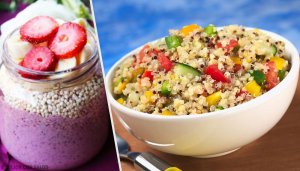Why You Should Eat Quinoa


Written and verified by the pedagogue in physical education and nutritionist Elisa Morales Lupayante
Do you know why you should eat quinoa?
Quinua is a seed that’s also known as “mother of all grains”. It’s a plant from the family of beets and spinach. It contains different nutrients in both its seeds and leaves.
Among its nutrients are amino acids, unsaturated fatty acids, vitamins, minerals and it’s also high in fibre.
Quinoa contains around 16 grams of protein per 100 grams. Plus, it also contains 6 grams of fat for every 10 grams of grain.
Properties
Quinoa has some pretty amazing properties. Here are just a few:
- High level of proteins, up to 25%
- It contains minerals: iron, magnesium, calcium
- Vitamins: C, E, B1, B2 and B3
- It’s rich in amino acids
- It provides omega 6 fatty acids
- Its glycaemic index is very low
- It’s rich in fibre
Benefits
1. It helps you lose weight

Do you want to lose weight? Then don’t hesitate to include quinoa in your diet.
- Its fibre and protein content helps accelerate the digestion process. Therefore, it reduces the problems of constipation.
- It also eliminates bad cholesterol (LDL) that is lodged in the walls of the intestine.
- Furthermore, its iron and vitamin B12, which help in the burning of energy and weight loss, must also be taken into account.When your body doesn’t have enough vitamin B, nutrients are not synthesized efficiently.
- In addition, eating quinoa makes you feel more full.
2. It reduces cholesterol
- As already mentioned, quinoa contains soluble fibre. This helps eliminate excess fat every time we eat something.
- Also, the amount of fatty acids it contains increases good cholesterol (HDL) and reduces bad cholesterol (LDL).
- Plus, don’t forget the antioxidants which help speed up metabolism and clean the fats that clog the arteries.
3. It’s a source of energy

If there’s one food that shouldn’t be missing from an athlete’s diet, it’s quinoa.
- Quinoa is a cereal that contains proteins and amino acids, which are essential for building muscle and repairing tissues after physical exertion.
- Minerals and hydrates make it an essential source of energy.
- Quinoa contains twice as much protein as other grains.
4. It hydrates your skin
Quinoa is an antioxidant food composed of flavonoids. These are responsible for preventing premature ageing and purging excess toxins in the body.
It also contains lysine, which helps in the production of elastin and collagen. This helps damaged tissues heal faster.
Finally, it also contains riboflavin which contributes to the elasticity and softness of the skin.
5. It reduces migraines

When a migraine occurs, there is vascular enlargement because the nerve fibres that surround the blood vessels in the brain are stretched. This causes pain, inflammation and muscle spasms.
Quinoa has a large percentage of magnesium. This mineral improves blood circulation and especially has the ability to relax the veins.
6. It’s ideal for celiacs and diabetics
Quinoa is gluten free. Therefore, including it in your diet doesn’t pose any danger for people with coeiac disease.
Diabetic people can benefit from its low glycaemic index, which regulates blood sugar levels and controls blood pressure.
7. It strengthens hair

Its combination of nutrients, vitamins, calcium, and phosphorus increases the hydration of the scalp. It also prevents dryness and controls the appearance of dandruff.
How to prepare it
Quinoa germinates very quickly, and it’s a great way to consume protein without resorting to meat.
Ingredients
- ½ cup of quinoa (100 g)
- 1 tbsp. of olive oil (16 g)
- 1 glass of water (200 ml)
- Salt (to your taste)
Preparation
- First, wash the quinoa well under the tap for a few minutes.
- Then, heat the oil in a pan and add the quinoa to sauté.
- Add the water and add salt to taste.
- Finally, cover and let it simmer.
Ways to use it
Once cooked, quinoa can be used in:
- Soups or salads
- Quinoa flour is useful in making cakes and cookies.
- It’s good for making cereals and granola.
Are you ready to include quinoa in your diet?
All cited sources were thoroughly reviewed by our team to ensure their quality, reliability, currency, and validity. The bibliography of this article was considered reliable and of academic or scientific accuracy.
- Food and Agriculture Organization of the United Nations. [Internet]. La quinua: cultivo milenario para contribuir a la seguridad alimentaria mundial. 2011. Disponible en: http://www.fao.org/docrep/017/aq287s/aq287s.pdf
- Hernández Rodríguez, J. La quinua, una opción para la nutrición del paciente con diabetes mellitus. Revista Cubana de Endocrinología, 2015; 26(3): pp. 304 – 312.
- Navarro-Perez D, Radcliffe J, Tierney A, Jois M. Quinoa Seed Lowers Serum Triglycerides in Overweight and Obese Subjects: A Dose-Response Randomized Controlled Clinical Trial. Curr Dev Nutr. 2017;1(9):e001321. Published 2017 Aug 24. doi:10.3945/cdn.117.001321
- Li L, Lietz G, Bal W, Watson A, Morfey B, Seal C. Effects of Quinoa (Chenopodium quinoa Willd.) Consumption on Markers of CVD Risk. Nutrients. 2018;10(6):777. Published 2018 Jun 16. doi:10.3390/nu10060777
- Vega-Gálvez, A., Miranda, M., Vergara, J., Uribe, E., Puente, L., & Martínez, E. A. (2010, December). Nutrition facts and functional potential of quinoa (Chenopodium quinoa willd.), an ancient Andean grain: A review. Journal of the Science of Food and Agriculture. https://doi.org/10.1002/jsfa.4158
This text is provided for informational purposes only and does not replace consultation with a professional. If in doubt, consult your specialist.








